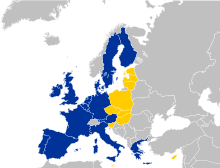
Back توسيع الاتحاد الأوروبي لعام 2004 Arabic Ampliació de la Unió Europea de 2004 Catalan EU-østudvidelsen 2004 Danish EU-Erweiterung 2004 German Cinquième élargissement de l'Union européenne French Եվրոպական միության ընդլայնում (2004) Armenian Allargamento dell'Unione europea del 2004 Italian 2004. gada ES paplašināšanās Latvian/Lettish Проширување на Европската Унија во 2004 Macedonian Vijfde uitbreiding van de Europese Unie Dutch

| History of the European Union |
|---|
 |
|
|
The largest enlargement of the European Union (EU), in terms of number of states and population, took place on 1 May 2004.
The simultaneous accessions concerned the following countries (sometimes referred to as the "A10" countries[1][2]): Cyprus, the Czech Republic, Estonia, Hungary, Latvia, Lithuania, Malta, Poland, Slovakia, and Slovenia. Seven of these were part of the former Eastern Bloc (of which three were from the former Soviet Union and four were and still are member states of the Central European alliance Visegrád Group). Slovenia was a non-aligned country prior to independence, and it was one of the former republics of Yugoslavia (together sometimes referred to as the "A8" countries), and the remaining two were Mediterranean island countries, both member states of the Commonwealth of Nations.
Part of the same wave of enlargement was the accession of Bulgaria and Romania in 2007, who were unable to join in 2004, but, according to the European Commission, constitute part of the fifth enlargement.
- ^ "Archived copy" (PDF). Archived from the original (PDF) on 6 October 2018. Retrieved 21 July 2014.
{{cite web}}: CS1 maint: archived copy as title (link) - ^ White, Michael (21 July 2014). "Twenty years of Tony Blair: totting up the balance sheet". The Guardian. Retrieved 5 September 2017.